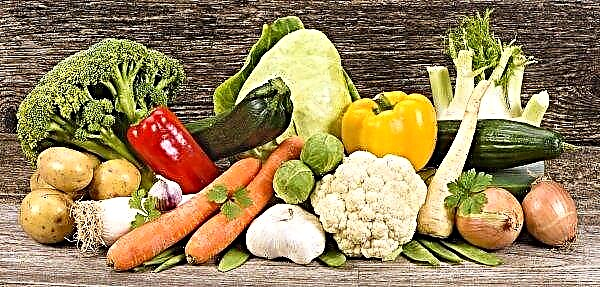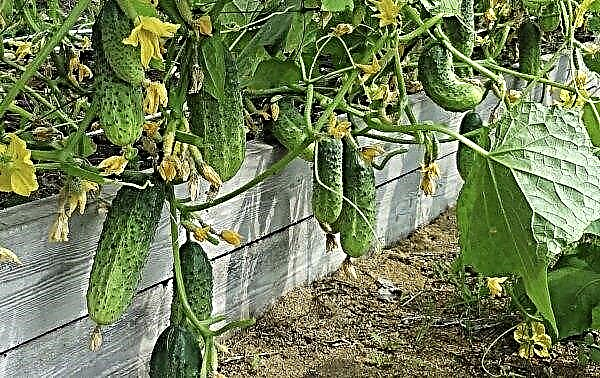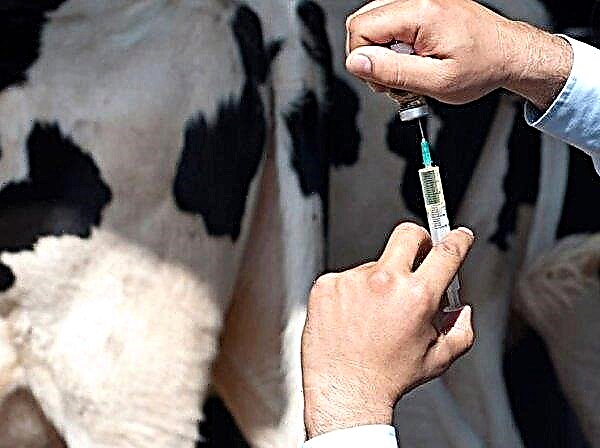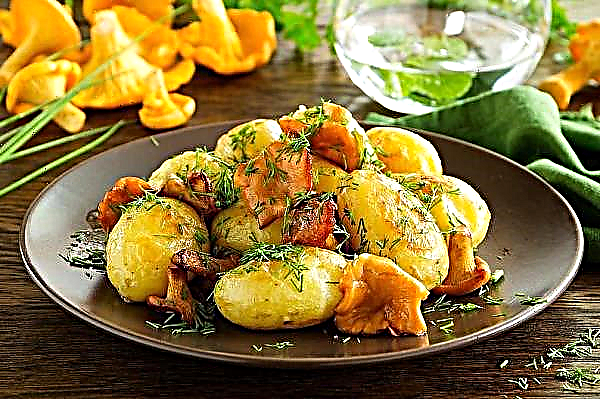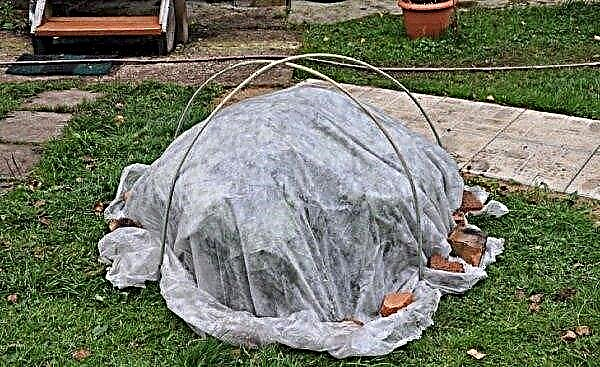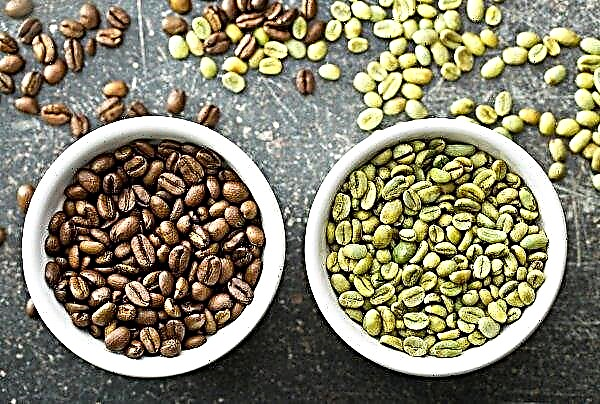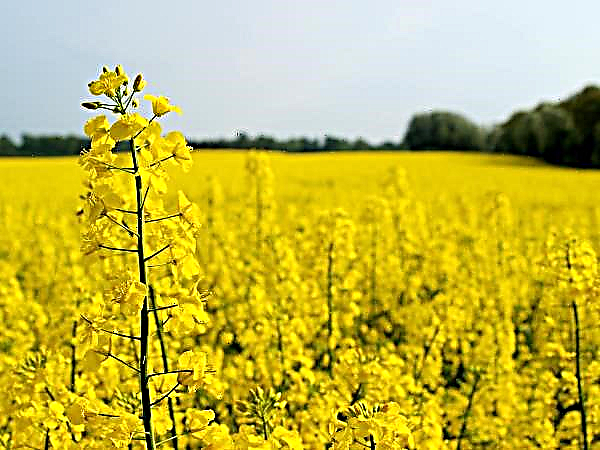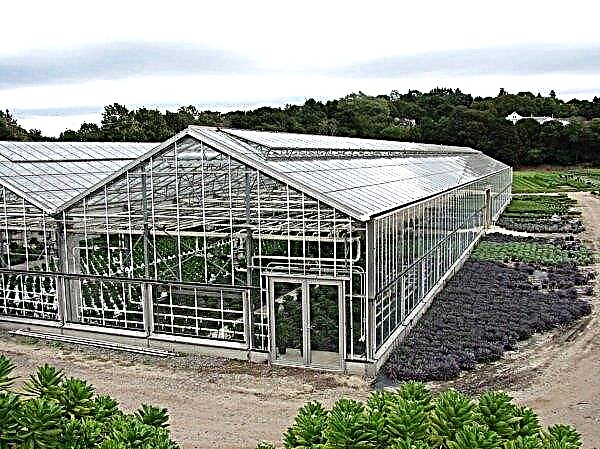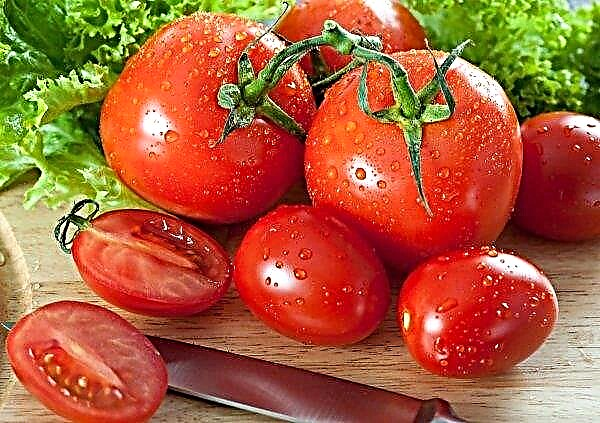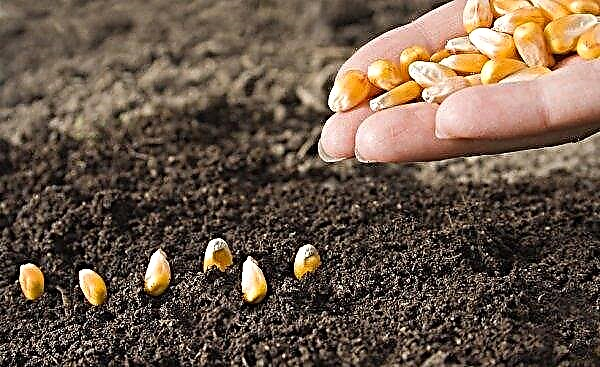Growing different varieties and types of onions in the garden will help to avoid trouble when, for some reason, this or that variety does not give the expected yield. Unpretentious to the conditions of cultivation and high-yielding shallots, subject to the following agricultural rules, will always please both early vitamin greens and bulb stocks for the winter.
Did you know? Distinguish between sweet, semi-sweet and spicy onion varieties, and sweet onion contains less sugar than in spicy.
Characteristics of shallots
Shallots are an independent variety of onions. Often in the country or in the infield, it is grown together with other varieties of onion crops. Gardeners are attracted by such shallot qualities as:
- unpretentiousness when growing;
- resistance to low temperatures in comparison with other grades;
- high productivity.

This variety of onions is characterized by small white or bluish heads, which form a whole family around the planted onion, for which this variety was commonly called family. In taste and nutrients, it does not differ from other varieties of onion crops, but differs in growth characteristics and differences in the quality of varieties:
- as the onion sets do not increase in volume, they begin to divide and form a large number of children;
- onion heads and leaves have a sweeter and softer taste without sharpness and pungency of onions;
- without loss of productivity withstands temperatures of -4 ... -5 ° C;
- ripening takes place within 70 days, shallots can be considered an early ripening variety;
- the green mass is plentiful, soft and does not become stiff as it grows;
- bulbs do not dry out, do not germinate and do not rot during storage;
- shallots are convenient to use, their small heads are considered a delicacy in cooking.
Did you know? In terms of vitamin C, green onions (30 mg) are equal to gooseberries and only slightly inferior to lemon (40 mg) and mandarin (38 mg).
Popular shallots
Thanks to the work of breeders, gardeners have a large selection of onion varieties, which can be selected based on the climatic characteristics of the cultivation region. Some varieties are described below:
- Airat - mid-season, 5-6 bulbs in a bush weighing 20 g.

- Kuban yellow - 4-5 bulbs in a bush of 30 g each, cultivar and drought tolerant variety.
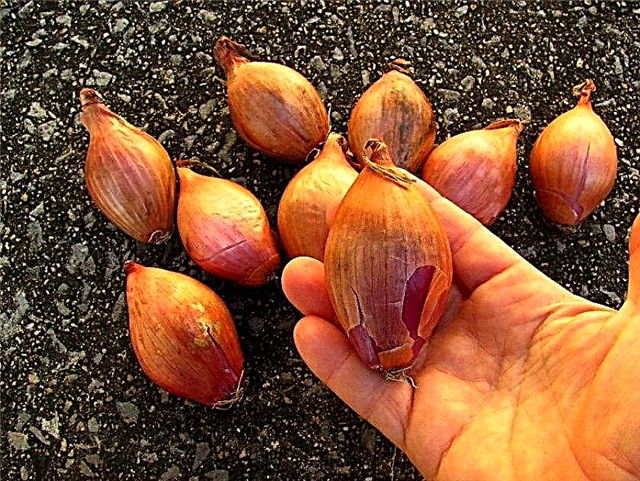
- Banana - the sweetest variety, an oval bulb of violet-pink color up to 100 g.
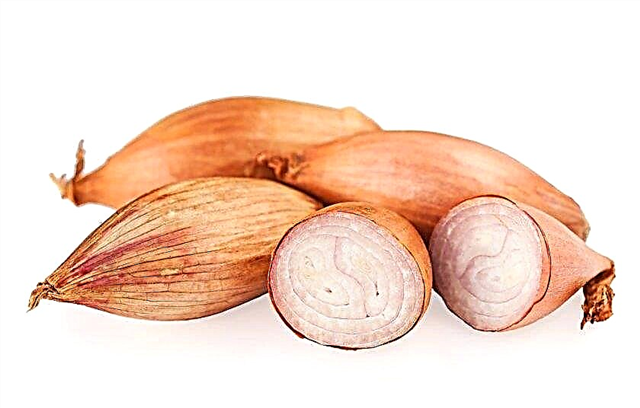
- Sir-7 - the early ripe most productive variety, which ensures the presence in the bush of up to 7 bulbs of 40-70 g each.

- Emerald - early variety, 4-5 bulbs in a nest of 20 g each

- Vonsky - medium late variety, resistant to diseases and damage by pests, 3-4 bulbs in a bush of 30-70 g.

- Delicacy (Yummy) - the earliest variety, already 25 days after sowing seeds, you can collect herbs, in the nest of 4-5 large bulbs up to 130 g.
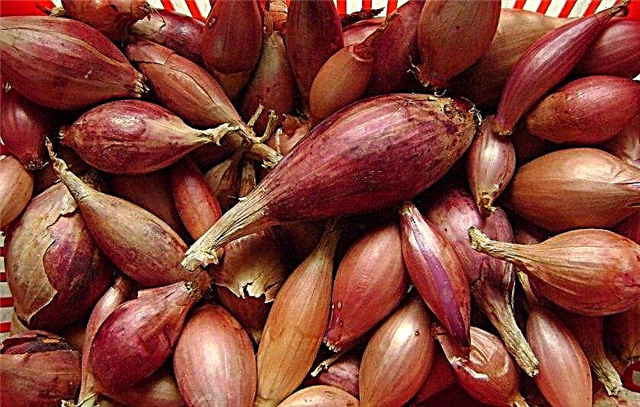
- Star - early variety, ripening in 55 days, with a sharp taste, fruitful, resistant to drought.
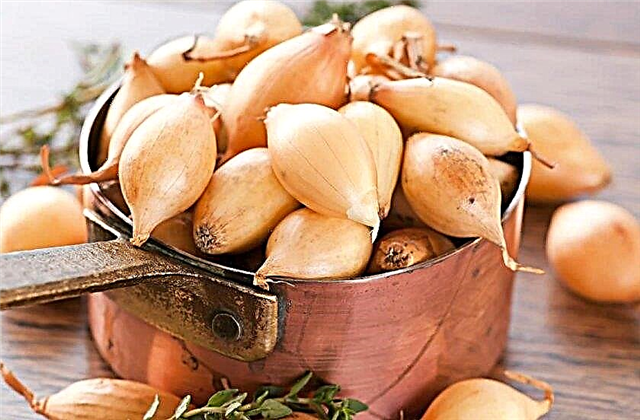
There are other varieties from which the gardener can choose the best for growing on his site.
Landing shallots in open ground
Proper planting will provide a good crop of vegetable crops, will allow you to get a sufficient amount of greenery or to grow quality onions.
Important! Soil acidity can be checked with litmus papers, which are sold in specialized stores along with instructions.
When to plant in open ground
Onions are resistant to low temperatures, but despite frost resistance, they should not be planted in the winter. Long-term exposure (from 1 to 3 months) of lowered temperatures increases the percentage of rifling (75% during winter plantings and 15% rifling during spring planting). This means that the plant is moving from a two-year development cycle to a one-year cycle. Due to its early maturity, shallots have time to ripen in one season, even with spring planting. Bulbs less than 1 cm in diameter are selected for winter planting - they usually do not give arrows.
Depending on the method of using shallots - on greens or turnips, planting dates also vary:
- when the land warms up (in March-April), they arrange planting on greens, and in May it is already possible to collect an early crop of green feather;
- in April-May plant sowing to form a full-fledged turnip bulb;
- winter planting on greens is carried out in October-November, so that the plant has time to take root, but does not grow;
- autumn plantings will give spring onions in April, and heads in early summer.
The planting plan for planting is as follows:
- smooth rows of grooves;
- bulb embedment depth 2-3 cm;
- between rows - 20-25 cm;
- the distance between the seeds is 10-12 cm for the nest to grow.
Important! If you sprinkle onion seeds with chalk or tooth powder before sowing, you can control seed consumption and planting frequency.
Necessary soil
Onion beds are preferably located in a sunny area, away from trees and shrubs to avoid shading. This vegetable crop loves loose, non-clay, moderately moist humus-sandy soils that are well ventilated, eliminating moisture stagnation.
In places with high humidity, the beds should be raised above the soil level by 20-25 cm. Acidic soils on which the crop loses its quality should be avoided - the bulbs will be small and stiff. It is advisable to prepare the soil on the beds for planting in the fall.
For this, the site is dug up, weeds are removed, the nutrient mixture is added per each square meter:
- compost mixture - 6 kg;
- superphosphate - 50 g;
- ash - 200 g.
Important! In dense soil, the bulbs grow small. To provide a place for the family to grow and increase the size of the heads, you can put a little soil in the center of the nest and squeeze, carefully pushing the children apart.
Then you can plant onions
When preparing beds for onions, it is necessary to adhere to the rules of crop rotation:
- Onions can be planted in the same place only after 4 years due to the possible development of diseases and pests of onion crops.
- The best precursors for onions are herbs, legumes, early cabbage, potatoes, tomatoes or cucumbers.
- And from the places where carrots, garlic, sunflowers, corn were grown, it is better to refuse.
- The proximity of crops such as radishes, strawberries, lettuce, carrots, and cucumbers can provide pest protection. And the calendula and marigold flowers sown nearby, with their strong smell, will scare away insect pests.
- Due to the possibility of cross-pollination, avoid planting next to different varieties of onions and shallots.

How to plant onions in open ground
The rules for proper onion planting are as follows:
- Before planting, you must calibrate the set and select the heads for planting at least 10 g (2-3 cm in diameter) without damage and rot. Larger heads will give more babies than increase harvesting yields.
- Equal in size sowing will provide friendly seedlings, so it is advisable to plant in one place the same-sized bulbs.
- Before planting, the seed must be warmed up in the sun or a heating battery for 8 hours (temperature is about + 40 ° C), which will provide fast vegetation and exclude the shooting.
- Disinfect onion sets by soaking for half an hour in a pale solution of potassium permanganate (1%), and then in saline (200 g per 10 l of water) for 12 hours. This treatment will prevent the planting from becoming infected with a stem nematode and an onion fly.
- The soil should warm up to + 12 ° C, lower temperatures will slow the growth of the plant.
- Planting grooves need to be shed well, plant bulbs in moist soil to a depth of 4 cm, slightly pressing in to avoid leaching.
- With a long cold snap, cover the onion planting with a film or other non-woven material.
- With prolonged propagation by the vegetative method, the bulbs degenerate, yield decreases, in which case reproduction is carried out by sowing seeds.
- When growing onions from seeds in the first season, you get a set of seeds, and only for the second season you can get a full onion.
- Preparation of seeds for sowing includes pre-soaking to verify germination and treatment with growth biostimulants according to the instructions.
Cultivation and care
Crop care and further cultivation consists in timely weeding, thinning, loosening, watering and fertilizing as necessary.
Watering
Onions are 90% water, so it needs to be saturated with moisture. Watering should be organized depending on weather conditions and the degree of drying of the soil, observing its moderate moisture. In rainy weather, you can refuse watering. In dry and hot periods, watered every 2-3 days with active growth. Three weeks before harvesting, watering is stopped so that the bulbs get stronger and well stored in the future. The need for watering can be determined by the condition of the green onion feathers: with a lack of moisture, they look dry in appearance and become hard, and with an excess - watery and pale. The alternation of drought and strong moisture should not be allowed. This leads to the formation of dry and juicy layers inside the bulb, which will affect the quality of storage. Watering is carried out in the evening by water heated in the sun.
The need for watering can be determined by the condition of the green onion feathers: with a lack of moisture, they look dry in appearance and become hard, and with an excess - watery and pale. The alternation of drought and strong moisture should not be allowed. This leads to the formation of dry and juicy layers inside the bulb, which will affect the quality of storage. Watering is carried out in the evening by water heated in the sun.
Loosening and weeding the soil
During the period of active growth, onion beds require weeding, thinning and loosening. One of the important planting care activities is thinning. Without this procedure, large heads in the nest cannot be grown. Choosing small families from the garden, they thereby free up a place for nest growth, where larger children will form.
Selected onions come in handy for salads as early greens. Loosening is necessary for aeration of the soil, increase in moisture and air permeability of the soil. This process is especially necessary after irrigation to prevent drying of the soil and the formation of soil crust. Loosening is carried out to a depth of 4-5 cm, trying not to damage the bulbs and the superficial root system. During the season, 5-6 loosening may be necessary, which combine with weeding, while removing weeds that obscure and inhibit the growth of onions.
Loosening is carried out to a depth of 4-5 cm, trying not to damage the bulbs and the superficial root system. During the season, 5-6 loosening may be necessary, which combine with weeding, while removing weeds that obscure and inhibit the growth of onions.
Fertilizer application
If in the autumn onion beds were fertilized, then during the season, fertilizing can be done twice:
- when seedlings appear (after 15-20 days) with manure with water (1:10), reapply after three weeks;
- in the formation of bulbs, the plant needs phosphate and potassium fertilizers, which are administered according to the instructions.
Diseases and Pests
A careful examination and monitoring of the development of the plant will allow you to notice diseases and pests in time:
- With excess moisture, the onion is affected fungal neck rot. It is necessary to carefully inspect and clean the beds from damaged plants, and planting treated with antifungal drugs.
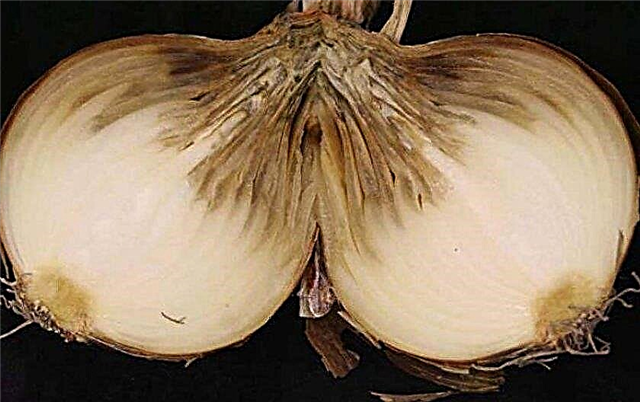
- From onion fly damage, sow crops with tobacco or saline (200 g per bucket of water), and process with tobacco dust or ash.
- Whitish spots on feathers evidence of thrips. If they are detected, treat onion beds and neighboring crops with insecticides.

- Early plantings will protect shallots from defeat onion fly since the insect is not able to harm well-rooted plants.

Features of harvesting and storage of crops
Onion ripening time and, consequently, harvesting time depend on weather factors. This usually occurs between July and early September. It should be guided by the condition of the tops - partially yellowed and lightly laid serves as a signal to start harvesting. It’s not worth delaying this, since it is possible that the roots will grow again, which will lead to a deterioration in quality and taste.
The onions are pulled out of the beds and placed under a canopy or in a room with good ventilation for ripening and drying. You can leave to ripen in the beds, if there is no morning dew, and no precipitation. The leaves are not cut, since during drying the bulb will take the necessary substances from the tops and strengthen. After two weeks, the onion will be ready for storage - the heads draw moisture from the tops and it dries.
Dry feathers can be trimmed, leaving 2-3 cm, or weave onions into braids. Store onions at room temperature or in dry and cool rooms with good ventilation, it does not dry out and does not germinate within 5-7 months. Small onions can dry during storage, but they can be pickled, while receiving a good vitamin supplement to food.
Novice gardeners should pay attention to this variety of onions, because with simple care and the implementation of simple cultivation methods, you can get good yields of quality products and provide yourself with a vitamin delicacy.













